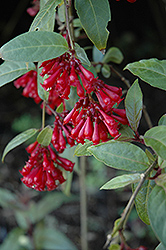Height: 8 feet
Spread: 6 feet
Sunlight:
![]()
![]()
Hardiness Zone: 8b
Other Names: Jessamine
Description:
This stunning evergreen shrub produces showy masses of crimson tubular flowers over a long period followed by interesting red berries; plant in sheltered area of the garden or along borders; may resprout from roots after a hard freeze;
Ornamental Features
Red Cestrum features showy clusters of crimson tubular flowers at the ends of the branches from early spring to late winter. It has bluish-green evergreen foliage which emerges green in spring. The pointy leaves remain bluish-green throughout the winter.
Landscape Attributes
Red Cestrum is a dense multi-stemmed evergreen shrub with a shapely form and gracefully arching branches. Its average texture blends into the landscape, but can be balanced by one or two finer or coarser trees or shrubs for an effective composition.
This is a relatively low maintenance shrub, and usually looks its best without pruning, although it will tolerate pruning. It is a good choice for attracting birds, bees and butterflies to your yard. It has no significant negative characteristics.
Red Cestrum is recommended for the following landscape applications;
- Accent
- Mass Planting
- General Garden Use
Planting & Growing
Red Cestrum will grow to be about 8 feet tall at maturity, with a spread of 6 feet. It has a low canopy, and is suitable for planting under power lines. It grows at a medium rate, and under ideal conditions can be expected to live for approximately 30 years.
This shrub does best in full sun to partial shade. It does best in average to evenly moist conditions, but will not tolerate standing water. It is not particular as to soil type or pH. It is somewhat tolerant of urban pollution, and will benefit from being planted in a relatively sheltered location. Consider applying a thick mulch around the root zone in winter to protect it in exposed locations or colder microclimates. This particular variety is an interspecific hybrid.
Disclaimer - This resource is provided for informational purposes only and does NOT reflect current availability. Inventory varies seasonally, so we cannot guarantee that every plant will be in stock at all times - please contact your favourite GardenWorks location directly for current availability. It does not include our entire inventory of plants, so be sure to visit GardenWorks to see varieties that may not be represented on this list.

